On bee-in' busy - and how to be productive instead
Oh no, not another productivity thingy
"Sorry, I'm busy!" we say almost proudly. Or defensively? Over time, however, frustration sets in. The frustration of things somehow moving slowly, of wasting low-energy hours on just being... present? Fiddling with things simply because it is the designated working time?
This is what happens if we do not differentiate between busyness and productivity.
Dear reader, this article is no elaborate 'follow this blindly for great success' system. No shallow 'just have more willpower and get up early' advice. But instead, some common sense reflections your daily routine frequently drowns in its glorious chaos. I am almost willing to bet: You already know this. Somehow, unconsciously. It is neither witchcraft nor rocket science, but building conscious mental models around the concept of 'productivity' helps incorporate sustainable behavior in one's life.
Busyness vs. productivity
Ok, let's do this. My suggestion to differentiate the terms:
- Busyness: The degree of being occupied working on tasks.
- Productivity: Rate with which we successfully transform 'inputs', whatever that means.
。◕‿◕。
Whatever that means.
。◕‿◕。
... I mean.
Yes yes. A brief taxonomy, as usual. Here it is. Hope you're happy...
- Output productivity is a function of 'quality of work' times the 'throughput per unit of time'. So output can be measured by multiplying the time spent on a task by its 'output productivity'. Closely related to efficiency, this can be summarized as 'How quickly and in which quality do you do stuff?'
- Outcome productivity results from 'output productivity' times its 'share of working on the right things within your specific context'. Focussing on value and closely related to effectiveness, this can be summarized as 'To which degree do you produce desired or intended (business) results?'
- Impact productivity results from your 'outcome productivity' times the 'leverage your context provides' multiplied by the result's 'relative impact'. This is the vaguest and most difficult-to-measure category, as it literally encompasses the whole environment. In short: 'To which degree do you impact the world?' (Please note that the relative impact can be negative even for highly positive outcome productivity. Looking at you, recommender systems of social media!)
These can now be applied at different levels of granularity, at the individual or the team level, etc. Now, this is still very complicated, and we won't dive deeply into measuring productivity within this article's scope.
。◕‿◕。
Why not? This sounds fun!
Another time. But to name a few concepts: leading and lagging indicators, impact attribution, compound and spillover effects, delayed results, ...
。◕‿◕。
Jeez, ok. I get the picture.
Thank you. So back to how we can get productive instead of being busy. Over time I reflected a bit on this and concluded that it isn't difficult, per se. Theoretically speaking.
Here are my musings on the concept of productivity for knowledge work. With a focus on the personal kind.
While starting with an overview, buckle up if you want to read it thoroughly. It's gonna be a ride.
In short
- Context is king: Generating output is relatively trivial, but unless you are happy to waste your time working on the wrong things, understanding context is the only way to take accountability and steer in the right direction yourself. To your lazy self's dismay, this requires you to think critically instead of blindly following processes. Fortunately, it also allows you to own the outcomes of your work - and improve your systems on the fly.
- Put your systems up high: Goals are ephemeral and often binary - fail or succeed. And then what? To truly reach success, focus on the long-term health of your habits, behavior, and processes. You don't raise to your goals. You fall to the level of your systems.
- Climb your hills: At a task's beginning, there is the ascent to figure things out. As ascents are challenging to climb, our brain urges us to procrastinate with more manageable tasks. Evade this trap - and once you overcome the uncertainty, you have the slope of an easy ride before you.
- Motivation comes from doing: Ever had a task you really didn't want to start, procrastinating on it for days - but once you took it on, it was surprisingly easy to get into? And the daunting feeling went away in the first 5 minutes? Truth is, motivation is a feeble creature. Don't rely on it. Do the first step. The second might just follow...
- Context switching is expensive: Humans are terrible at conscious cognitive multiprocessing – what we perceive as multitasking are just fast but costly attention switches. It takes even a neurotypical person ~23min to truly regain focus after an interruption. Focus on one task at a time and remove distractions.
- Done is better than perfect: You know this bon mot, the Pareto principle, and the 80/20 rule. Yes, yes, of course, perfection takes a lot of time. But what does this actually mean? Let's dive into why pragmatism is, well, pragmatic. Consider the opportunity cost of delay, diminishing returns on time, and why iterating on smaller chunks of work helps you keep on track.
- Your brain is for thinking: Our brain is rather good at processing certain kinds of information. But conscious resources are extraordinarily limited. Set up your work so you can focus on thinking as much as possible - and not have to consciously juggle reminders, appointments, and deadlines in your mind. Oh, and make those pesky micro-tasks easy.
- Sharpen your axe: I don't know about you, but I hate when I notice that I'm working inefficiently. And more often than not, this stems from the simple fact that my tools are not up to speed. And I'm not talking about OneDrive's sync here - but instead the preparation of knowledge, templates, and procedures that could aid me when prepared right. So let's prepare them right.
- Beware of structural debt: If it isn't missing context or your dull axe, inefficient work usually stems from structural debt. Do you remember that excel you set up for some quick calculations? And then you added some more, and now everything relies on obscure muddy hidden helper tables you'd be ashamed to show your grandmother? Refactoring a mess is never fun. Yeah, don't overengineer, but keep the fundamentals clean if there is a real possibility that the scope expands or you have to restructure something. At least be consistent in structure and don't break interface conventions.
- Don't solve problems, eliminate them: Ever worked on a challenge and had an elaborate solution in mind, executing it flawlessly in its intricate details - only for your colleague Chloe to come along and propose a totally different, straightforward approach that solves the actual problem nevertheless? And down the drains with your days working on it. Always ask yourself: 'What do we actually want to achieve?' Because, sometimes, to overcome a local optimum, you have to take a leap of faith.
- Saying no saves the most time: Self-explanatory yet oddly tricky for most. Whether you struggle saying no to others or yourself - if the task does not truly align with your scope, context, objective, and best-fitting responsibility, consider how much this hurts your other endeavors. Opportunity cost, folks. It is no joke.
- Live your pace: Or also: know thyself. Some work best in short, highly productive sprints and then need recovery time, while others maintain a steady, sustainable pace. Both are fine, and knowing which fits you best enables you to structure accordingly. Yes, there is legitimate crunch time, and yes, there is some amount of pace adaptability. But work consistently above your natural pace and you'll hurt your bottom-line productivity, at worst, permanently. Which is objectively a bad choice.
1. Context is king
Generating output is relatively trivial. But this doesn't drive the outcome. And if you genuinely strive to drive your outcome productivity, you can't leave the questions 'are we working on the right things' and 'do we do this right for the current situation' up to chance. What do we need? Context.
Context on the result that shall be achieved. And the relevant context that influences both the decisions 'what' and 'how' to do it. As in practice, this highly depends on your... context; I'll leave you with a slight nudge about communications and briefings.
Two scenarios:
- Have you ever been given a task to complete - yet after the briefing, you were at a loss for what to do? Not necessarily where to start, but genuinely not knowing what a good job might look like or what success criteria might be?
- Have you ever given someone a task to complete - and what was delivered was so divergent from your expectations that you have no idea how the miscommunication could have been so big? And be honest, did you clearly communicate context, cutting communicative corners, or maybe missing it on your own but not communicating that fact?
I bet you have been. Here is the structure that inspires me in briefings - on both sides. The briefed should be able to answer these questions afterward.
- What is the overall situation?
- What is the challenge to solve?
- What is the goal behind the challenge?
- Where do solution ideas exist - and where are the briefed free to explore and decide?
- Are there specific constraints (time, scope, cost, etc.)
- Who is this for, and are there particular areas to emphasize or avoid?
- Who else is involved, and in which roles?
- What are the next steps?
And as context is king, the extent to which these individual points matter also depends.
2. Put your systems up high
Proponents of James Clear might know this - the idea is quite simple.
You don't raise to your goals. You fall to the level of your systems.
‒ James Clear
Goals are ephemeral and often binary - fail or succeed. And then what? What if you failed? What if you did, but only because you missed the mark by 2%? And if you succeeded, what next? Goals are great for giving direction, but in themselves, they don't make us more productive. Due to their ephemeral nature, much less so sustainably.
To truly reach success, focus on the long-term health of your habits, behavior, and processes. Your systems.
Don't focus too much on losing those pesky 5 lockdown kilos. Focus on living in a way that puts you in a calorie deficit. Eat a bit healthier. Move a bit more. And then measure your weight as a lagging indicator that steers your system.
This is a subtle but mighty shift. It actually puts your conscious focus on your behavior, not the goal. Bonus points if you focus on long-term sustainable change. And yes, 'Atomic Habits' is an excellent book.
。◕‿◕。
Ha! Now you did mention lagging indicators!
Yes, Timmy, I did. Some concepts do pop up regularly when I think about things. Wait 'til we get to opportunity cost; you'll be in for a treat. I could talk about these all day long. But I'm getting ahead of myself.
3. Climb your hills
There is this thing you should do that you have never done before. It is not big big, but still uncomfortably so. At least it isn't urgent... Oh well, let's park that for now, shan't we? Ok, nice. And these other things are more comfortable anyway. Look how they get completed. But somehow, there is this dread; this task lingers in the back of your head. You don't want to focus on it, but it doesn't let you relax, either. After several days, you start with it and the whole thing is way easier than imagined.
Congratulations, you just got tricked by your brain.
New situations and uncertainty in knowledge work require conscious effort to figure things out. And while your brain is tasked with thinking, it doesn't really enjoy it. Takes so much energy. Easier to chill and let habits and intuition take over. So it urges you to procrastinate on other stuff until things get urgent.
Funnily, your brain also does not like unresolved issues. So while you do other stuff, there is a subroutine working on it and sometimes reminding you to give it more resources. Conflicting signals, I guess.
。◕‿◕。
So what does this have to do with hills?
Imagine this: When you are introduced to this task, you stand in front of a hill. Completing the task is overcoming it to reach some point on the other side. From below, it isn't easy to gauge its steepness and height, but you do see that it will take some effort. You also can't see the other side of the hill. Is it descending rapidly? Is there a comfortable road or just cliffs? And how long is it to your actual destination? You don't know.
But the very moment you have gotten to the top, you know.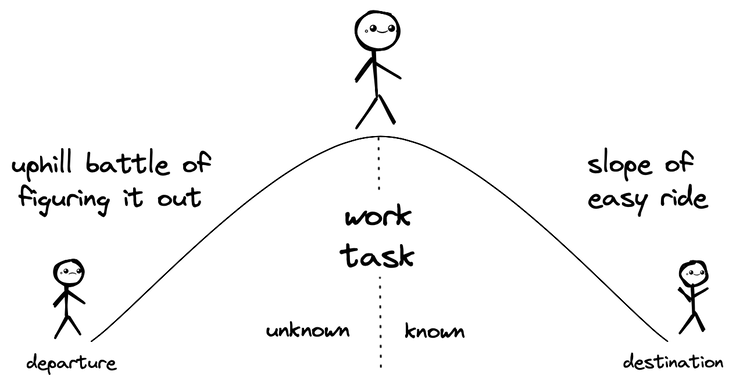
Maybe it is difficult. Maybe it isn't. But now you know what to expect and can plan and execute accordingly.
Reaching the 'peak of all my hills' as quickly as possible takes a massive burden off my mental load. In other words, figuring out an action plan and what to expect in execution.
Ask yourself: What are your hills? And wouldn't it work wonders for your mental health climbing them?
。◕‿◕。
Nice analogy, but how do we climb the hill?
Ah, erm, you know, starting at the end, planning backward, cutting the task into its necessary steps. Divide and conquer, so to speak. Outlining helps. Also, talking with others. How one always does, I guess. Anyway, there are still a lot of topics, so...
Disclaimer: This analogy is stolen from heavily inspired by Basecamp's Shape Up and their Hill Charts, which allow visualizing where you stand with figuring a project's tasks out.
4. Motivation comes from doing
This is a short one. Motivation is a feeble creature. It won't just magically hit you. At least not reliably. Quite similar to the hill analogy, do the first step. The second might just follow...
Need more? Ok, but I'll keep it brief.
There are some fundamental behavioral truths. Motivation won't reliably 'just magically appear'. Even disciplined people seldom have a lot of willpower. Once inert, your brain is lazy and doesn't really want to move.
Disciplined people often have mastered three simple things:
- Starting a thing even though not feeling like it
- Not immediately quitting it
- Repeating this process
Funny thing: once in motion, the brain doesn't mind. And so with repetition comes habit, and with habit comes the mental leeway to start another thing...
So what can you do? Well, it is a two-way street. Your brain may - and will - trick you, so why not trick it back? That'll show them!
Just start. I mean, not even start start. Genuinely plan to only work 3min on this. Read this mail. Sketch a reeaaally rough outline. Seriously, after, 3min you can stop.
Chance is, you won't. Inertia also works both ways. Thanks, Newton.
5. Context switching is expensive
As we already focus on the brain, let's dive deeper. Let's talk about multitasking and distraction. Let's talk focus. And implicitly, this flow concept.
Two fun facts:
- Humans are terrible at conscious cognitive multiprocessing – what we perceive as multitasking are fast but costly attention switches.
- It takes ~23min on average to truly regain focus after an interruption (according to the researchers of this study.
So, what are the costs of attention switching?
You see, there are different kinds of attention. Let's say 'perceptive attention' and 'constructive attention'. You guessed it - while we can quickly switch our perceptive focus, our constructive focus takes some buildup time. 23min to fully boot up. While multitasking, the tasks compete for resources of your attention that require a long startup time for each change of direction. This is also called task interference.
So distractions and task juggling rob you of a significant source of productivity. Those 2s of notifications lead you 20min down the social media rabbit hole. Even for purely work-related stuff: All it takes are 4 messages, and there go 2h down the drain. Not entirely, mind you, but there is... opportunity cost.
。◕‿◕。
Finally, opportunity cost!
Yeah, well, let's maybe wait until the next chapter. 1min max! Point is: deep, focused work is best for tasks that require constructive thinking. So, create an environment that supports that kind of work. Focus on one task at a time and remove distractions. Block it in the calendar, mute all notifications, close those tabs and apps, set a timer, and just start.
6. Done is better than perfect
You know this bon mot, the Pareto principle, and the 80/20 rule. All more or less the same idea.
But to dive deeper into the actual meaning of it, we have to understand the concept of opportunity cost. This time for real, promise! Ready? Ok, here it goes.
Opportunity cost is the implicitly lost value of the best alternative to a given decision.
。◕‿◕。
Well, that was underwhelming.
It feels like it, doesn't it? And therein lies a tragedy. We are not made to intuitively, truly grasp it in everyday life. But before I rant about the lure of instant gratification, let's take this apart.
Let's say you have €10 and only two decisions: Invest it in 'A' and get €15 back, or invest it in 'B' and get €20 back. Ceteris paribus, same conditions, no risk, etc. Naturally, you choose option 'B'. Your opportunity cost is €15, and your net profit relative to the best alternative €5. A sound decision. Selecting 'A' yields an opportunity cost of €20 - higher than our €15 profit. A bad decision.
Now let's introduce the third option: buying your partner a nice cone of ice cream. Real-world cost of ice cream aside, this complicates things. Option 'B' is still strictly dominant regarding option 'A' (writing game theory on my list of potential articles), but how to evaluate the utility of gifting ice cream to your partner? Well, this is impossible to objectively calculate. You just have to wing it. Love and stuff, you know.
Now let's introduce a fourth option providing 10% fixed return p.a. on top of inflation. And thinking ahead 40 years, we are now comparing buying your partner ice cream or having the equivalent of more than €450. Maybe this won't change your choice, and yet... Even with perfect information, decisions are hard.
This is further amplified by three factors:
- We unconsciously skew towards nearer-term decisions - our far ancestors didn't really care about the abstract self 5 years in their future, but having food now.
- The more abstract a decision's utility calculation, the easier we dismiss the option entirely instead of simply acknowledging its uncertainty.
- We really, really, really underestimate compound effects. The human mind has no intuition for it.
Now, this is no manifesto for the Homo Economicus. There is always uncertainty and risk, enjoying life is important, and value and perceived utility differ anyway. But sensibility to the concept itself brings many benefits.
Opportunity cost is no joke, and humans are prone to massively underestimate its effects.
Erm, why are we talking about this in such detail? Oh yeah: To truly grasp the following concepts as to why done is better than perfect.
6.1 Diminishing returns
Let's imagine a task of moderate size. Any such task. There will be activities that have a higher ROI on time than others. You might realize 80% of the task's value in the first 2 days and then spend 8 on making it perfect. Or spend the same 8 days to drive 4 more tasks to 80% value.
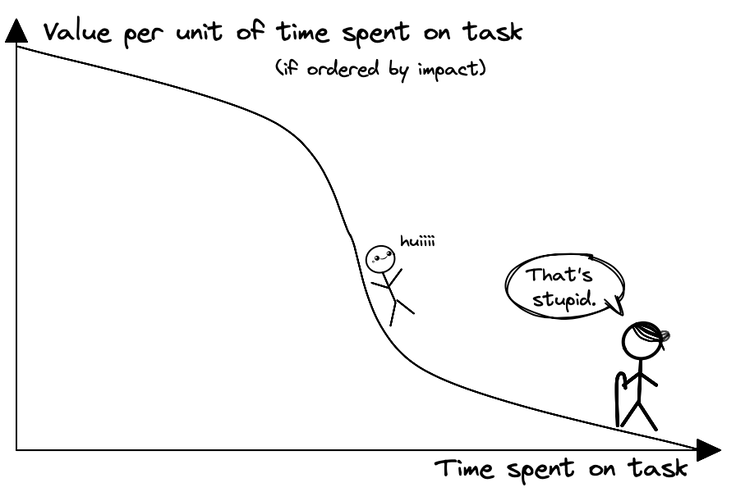
6.2 Cost of delay
This is a fun one. Imagine two tasks that can be in any arbitrary order, but due to your capacity, not in parallel. Both of them provide different value per unit of time they are completed. Consequently, their opportunity costs, while not completed, also differ. Let's call this cost: cost of delay. Using the anticipated time to complete the individual tasks and their cost of delay per unit of time, we can now rationalize the order to complete these tasks.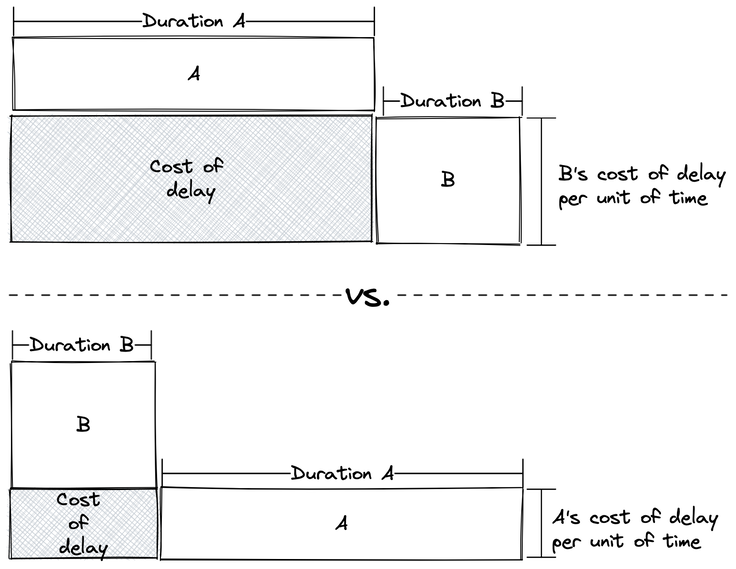
This model provides another insight into why multitasking (on tasks purely dependent on your work) has its downsides: Imagine you are doing these tasks concurrently. The cost of delay increases even more.
So what to do in practice:
- Minimize the cost of delay per task
- See if you can further break down your delivery to deliver high-value chunks earlier. They can provide value while you finish the rest, and feedback can already be gathered to inform further direction.
This leads us to a related topic: iterations.
6.3 Power of iteration
We already established the importance of context and chunking your work into smaller pieces to provide partial value. Iterating falls right at the intersection of those.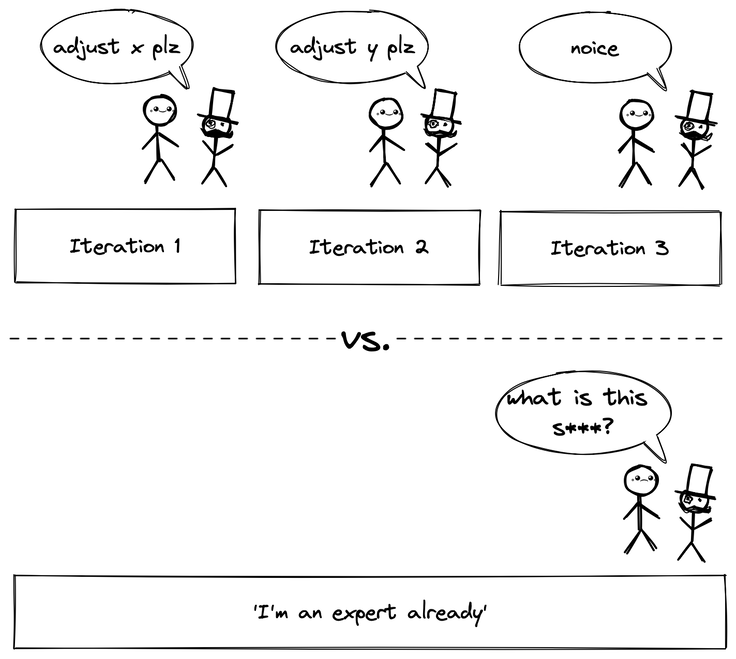
And as a result, you might even be to stop with the bells and whistles so you can stop sooner and work less.
So no purely new concept here; just re-iterating.
7. Your brain is for thinking
Our brain is rather good at processing certain kinds of information. But conscious resources are extraordinarily limited. Set up your work so you can focus on thinking as much as possible - and not have to consciously juggle reminders, appointments, and deadlines in your mind.
Think and outsource the rest. Oh, and make those pesky micro-tasks easy.
7.1 Outsource the rest
To navigate knowledge work effectively, there are many things 'to keep in mind' simultaneously. That project deadline, the action items derived in that meeting last Thursday, and the argument Sarah made against this thing Greg proposed. It's a lot. And Miller's law states (abridgedly!) that number of objects an average human can hold in short-term memory is 7 ± 2. And we are not even talking about thinking here.
。◕‿◕。
Let me guess, we'll categorize something to reduce complexity.
- Accidental complexity: The complexity we create (and possibly solve) while tackling the problem - that is not essential to the problem per se.
- Essential complexity: The true and unavoidable complexity of the actual problem
It follows that we should reduce accidental complexity where possible.
So what? What to do in the context of thinking?
Structure your systems to minimize the amount of non-essential cognitive effort you have to do. For example:
- Events: Turns out, calendars are really handy for those. Well, duh.
- Tasks: Now it gets interesting. Task management is something where context is crucial to set up well. At the minimum, track what needs to get done by when and link context. Bonus points for sharability, filterability, etc. But I'll stop here; just please manage your tasks.
- Docs & Notes: It also really helps to manage your notes centrally. If you don't yet take notes, take notes. Notes should be complete, sharable, easy to find, and summarize the key information at a glance - preferably the top. BTW, summarizing meeting results and sending them to participants has so many benefits; it's crazy. And for better and worse, who writes the protocol dictates what happened. Literally.
These three already suffice, and I'm sure you already employ some version of this. You may find some ways to improve on it. These setups are not free of accidental complexity, but it truly frees up your mind.
Addendum: To my knowledge, the difference between accidental and essential complexity was first - somewhat - classified by Aristotle and further refined in a system context by Turing Award winner Fred Brooks.
7.2 Make micro-tasks easy
Then there are many small things one can employ to increase the quality of life while working on something. Stuff you do 20, 30 times per day and distract you juuuust long enough to be a nuisance. Let's take a look at some areas.
- File search: Know your tools' and systems' search functions and store files and their content indexed and searchable, ideally at a single keystroke.
- Temporary file storage: Use a file shelf you can drag'n'drop stuff on.
- Repeating text: Use a text expander that gets triggered at specific character sequences.
- Managing your workspace: Use an app launcher and window manager, allowing you to set up and manipulate your desktop on the fly as needed.
I'm on a Mac and use Alfred and Yoink for these.
No, I won't get into any xmonad vs. i3wm (+ Rofi) wars with Linux users. Very jealous of y'all.
8. Sharpen your axe
Lincoln is quoted as saying:
Give me six hours to chop down a tree, and I will spend the first four sharpening the axe.
Sometimes it's eight hours, sometimes only one, and who knows if he said it at all; the point is: there is some real power in those words. Why?
Let's say you take the same time to chop down the tree with the dull axe as it takes you to sharpen it. What are the differences? Easy:
- You now have a sharper axe for the future
- You spent less energy in total
- Less probability of something stupid happening
Now imagine you want to chop down a second tree. Sharp axe! Muscles not too sore! First tree didn't crush your legs! Nice.
You can - and should - do the same in knowledge work. Build templates and checklists. Gather inspirational examples of good work. Learn a thing or two. Automate some stuff.
In short - build things that get you faster up your hills. This has the following benefits:
- It increases your throughput for a given task
- It preserves energy while doing it
- It decreases the probability of errors
- And these savings are repeatable and, in the case of actual artifacts such as templates, even scalable via others.
My go-to analogy for throughput is a pipe through which water (tasks?) flow. To increase throughput, you can widen the pipe (task capacity at a given time, e.g., by including other team members). You can also let things flow through faster. Sharpening your axe accelerates the flow.
Now you might ask: But I don't know if I'll save the time I invest into this.
You might be thinking about something like this (I'm creatively borrowing from xkcd here):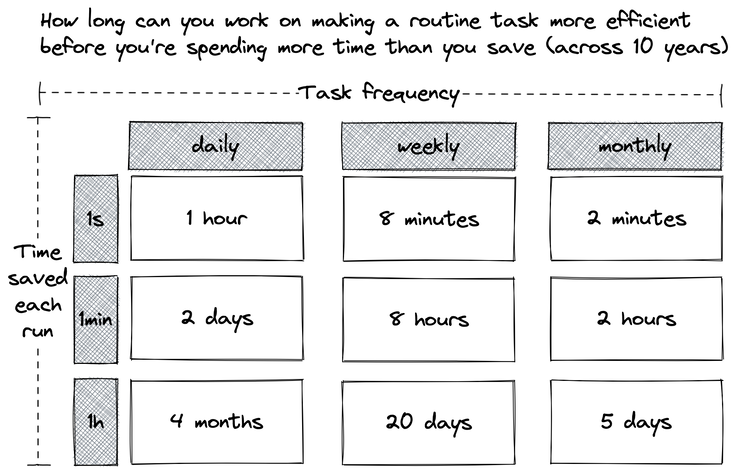
And you're right. I'll let you in on a little secret: There are significant inequalities regarding both effort and time.
- The inequality of effort to result is everywhere (we covered aspects of this via opportunity cost), but also
- Two moments are never of equal worth
Expounding on the latter, let's differentiate between 'crunch time' and 'dead time'. At 'crunch time', you have to perform. Create something of direct value. Be it a slide deck, a software feature, an excel, etc. At 'dead time', you have some time to do, you know, stuff. Organize, tidy up your mailbox, and review some minor things.
Use your 'dead time' to sharpen your axe. You might not regain the same amount of 'crunch time', but so what? They are not comparable.
A hidden fifth benefit of doing so is that you'll think things through. You learn. Sharpening your axe is an invaluable part of your productivity capital.
9. Beware of structural debt
If it isn't missing context or your dull axe, inefficiency primarily stems from structural debt. Do you remember that excel you set up for some quick calculations, then you added some more, and now everything relies on obscure muddy hidden helper tables you'd be ashamed to show your grandmother? Shame on you!
Yes, yes, of course, that salesperson needed these insights ASAP. Fast forward, half the sales organization runs on it. How did this go out of hand so quickly?
At least know you are not alone. Software Engineers having to handle big codebases for prolonged periods know this all too well and established (sometimes working) procedures for handling these situations. The rest of us don't. Until something breaks, and suddenly parts of your organization are paralyzed.
Simultaneously, we have to be pragmatic and not overengineer. So what to do? Well...
If there is a real possibility that (a) scope might expand, (b) you have to restructure something in the future, or (c) someone might want to re-use parts of your work:
In the beginning:
- Be consistent in structure: Structure the same things the same way. Format dates and names the same. Give comparable analyses of different topics the same layout. When working with multiple currencies, include a normalized conversion for comparison, but mark the individual currencies in the analyses, so they stay identifiable and attributable per data point. Overall: remain consistent and do not omit data that might be necessary for future classification. It would be a shame to revisit all these 500 websites again, wouldn't it? It's better to gather the context on what is or might be needed before diving too deep than to consolidate a bunch of stuff.
- Don't break interface conventions: Consider how others might access and use your info. Are there other sheets linking to yours? Have a stable output sheet that 'promises' not to change without notice (API much?). If it is a slide deck, don't mess up the master layouts and stay within them, so others can incorporate your slides into their decks, etc.
Later on: regularly revisit these artifacts and gather if and how refactoring actually makes sense. And if it does, free up the time and do it. It saves more in the long run (as you just evaluated).
Consolidation is never fun. Refactoring a mess, even less. Debt compounds, so take an eye on it.
Addendum: This also overlaps significantly with the different interpretations of the term 'MVP' in practice. But that is a topic for another time...
10. Don't solve problems, eliminate them
Ever worked on a challenge and had an elaborate solution in mind, executing it flawlessly in its intricate details - only for your colleague Chloe to come along and propose a totally different, straightforward approach that solves the actual problem nevertheless? And down the drains with your days working on it.
This mostly happens whenever we (a) have yet to truly think through the immediate and actual problem to solve and/or (b) have found a solution we genuinely like for some reason beyond its actual and immediate fit to the problem at hand.
I know I've been there many a time. Option (b), that is.
Always ask yourself:
- What do we actually want to achieve?
- What does (minimal viable) success look like?
- What are the first principles to solve this?
- Using these first principles, do we actually need this step?
It's great to solve problems. Often, it is unavoidable. But every sustainable solution - not elimination - not only takes tradeoffs but burdens us with its maintenance. So think twice. Because, sometimes, to overcome a local optimum, you have to take a leap of faith.
Disclaimer: I have to thank Kent C. Dodds for a great first nudge toward this thought on his very own blog.
11. Saying no saves the most time
Well, this is obvious. So why is this so difficult for most?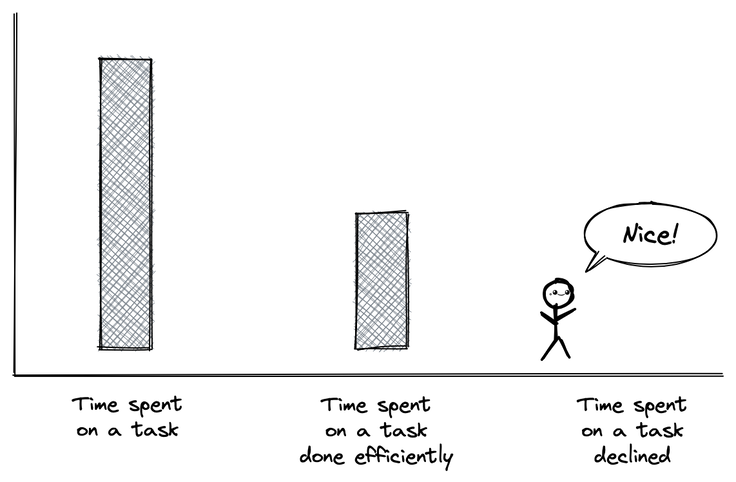
This has many different reasons.
Maybe you have a lot of interests and are attracted to 'shiny' new endeavors. Maybe you want to be liked, respected by others, appear reliable, or 'like a workhorse'. Maybe you can't differentiate well between important and non-important tasks.
Look, I feel you, but this is stupid.
You want to learn something? Then learn it. But either purposefully learn the highest-impact 10% and then close that chapter consciously or seriously commit to a thing until you really understand it. You want to perform for others? Turns out, a few really good results outshine the poor execution of many concurrent responsibilities. Only juggle a few tasks; if you want to do a lot, focus on increasing your throughput instead. And be honest with yourself. You kind of know what is important and what isn't. Opportunity cost strikes once again. It is no joke.
Don’t do something just because you can.
Ask yourself:
- Does this fit my intents?
- Does this have to get done?
- Am I the best person to do this (now)?
- What is the opportunity cost of doing it?
- Does this fit my capacity?
12. Live your pace
Last but definitely not least, the one topic that permeates all the rest and may decide your long-term productivity and health. Push yourself, but don't overdo it.
Know thyself. How do you work best? In short, highly productive sprints with real rest and recovery time in between? Nice! Or instead while maintaining a steady, sustainable pace? Also, nice!
Both are fine, and knowing which fits you best enables you to structure accordingly. The 'just master your mind and work like a beast' folks are partially correct; there is legitimate crunch time, and there is adaptability to increased workloads if done right. But work consistently above your natural pace and, you'll hurt your bottom-line productivity, at worst, permanently.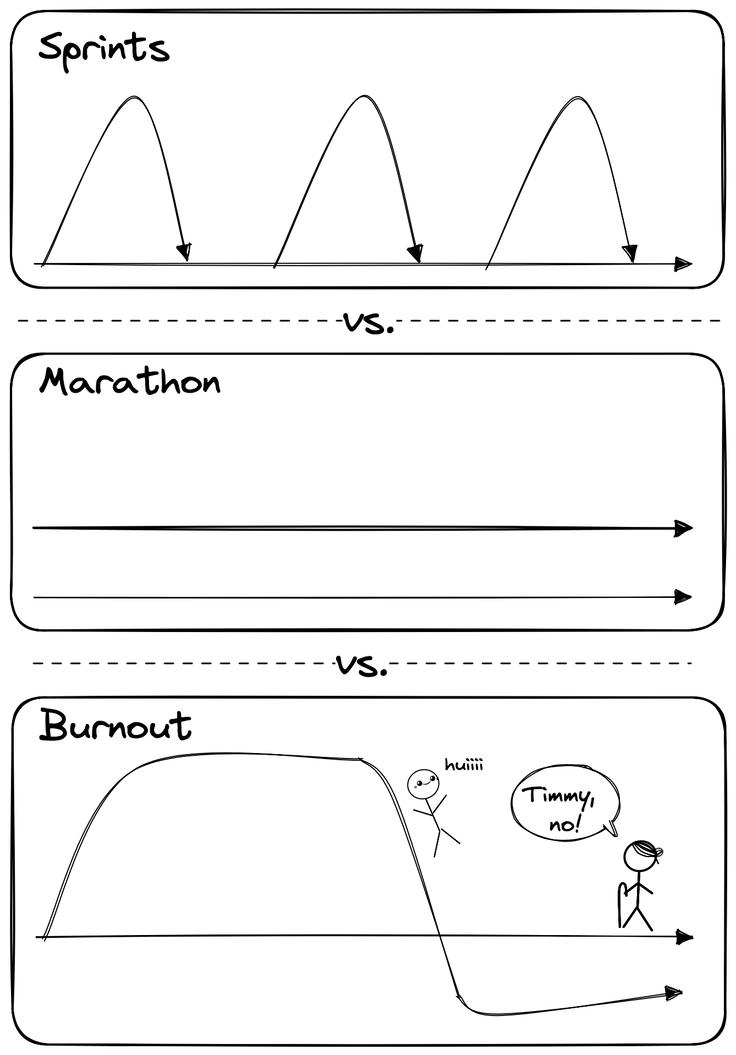
Mental burnout, decreased physical fitness and health, and lack of sleep can all leave lasting damage. Imagine the opportunity cost of working for the next 20 years with only 80% of your baseline. Turns out, burning yourself out is objectively a bad choice. On the contrary, it is paramount to maintain a good level of health, fitness, and sleep.
In both work and personal matters goes: Live the conscious, sustainably productive life. It is a good life.